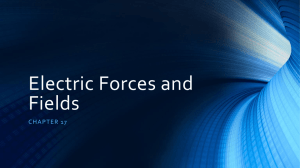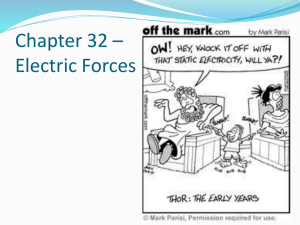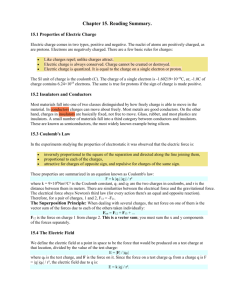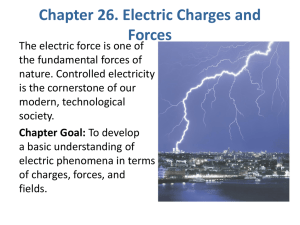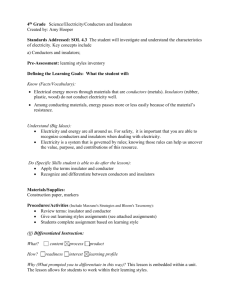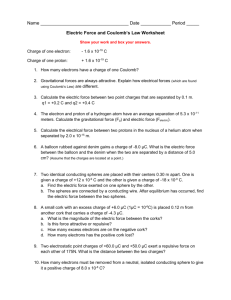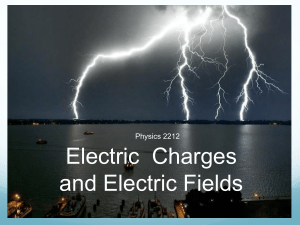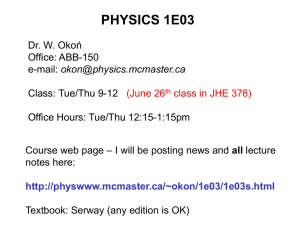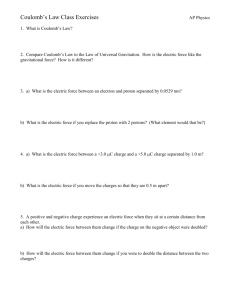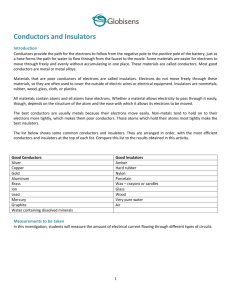Electric Field and Electric Charge
advertisement
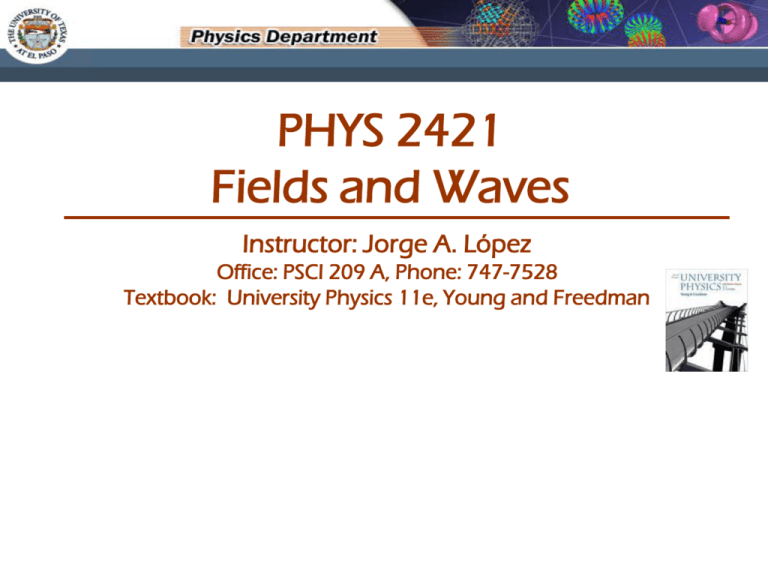
PHYS 2421 Fields and Waves Instructor: Jorge A. López Office: PSCI 209 A, Phone: 747-7528 Textbook: University Physics 11e, Young and Freedman Chapter 21: Electric Charge and Electric Field 21.1 Electric charge 21.2 Conductors insulators, and induced charge 21.3 Coulomb’s law 21.4 Electric field and electric forces 21.5 Electric field calculations 21.6 Electric field lines 21.7 Electric dipoles Section 21.1: Electric charge Amber can attract stuff Section 21.1: Electric charge Examples of electrostatics Section 21.1: Electric charge Benjamin Franklin (1706-1790) figured out There were two kinds of “charges” When a charge is produced on one body, an equal but opposite charge is produced on the other body He arbitrarily call them positive and negative. Equal charges repel Unequal charges attract Section 21.1: Electric charge Electric charge and the structure of matter Subatomic particles are the source of electricity Charge of e = - charge of p Charge of e is a unit of charge Electrons can be removed from atoms “Ions” are atoms with excess charge Section 21.1: Electric charge Summary of Section 21.1 • There are two kinds of charges: + and – • There is charge conservation • Equal charges repel, unequal charges attract • Subatomic particles are the source of electricity • Charge of e = - charge of p • Charge of e is a unit of charge • Electrons can be removed from atoms • “Ions” are atoms with excess charge Section 21.2: Conductors, insulators and induced charge Copper atom, 29 electrons Conduction electron Piece of copper metal Electrons can hop from atom to atom Process requires a force Protons are fixed with material Path of electron in iron (2 valence electrons) Section 21.2: Conductors, insulators and induced charge Insulators can be charged by friction “Conductors” can conduct electrons Insulators cannot conduct Semiconductors are in between Conductors must be charged in isolation Section 21.2: Conductors, insulators and induced charge Charging by induction Section 21.2: Conductors, insulators and induced charge Charging by induction Section 21.2: Conductors, insulators and induced charge Attraction of neutral insulators by polarization Polarization: Section 21.2: Conductors, insulators and induced charge Summary of Section 21.2 • Electrons can hop from atom to atom in conductors • Insulators cannot conduct • Protons are fixed with material • Insulators get charged by friction • Charging by induction • Attraction of neutral insulators by polarization Homework for Section 21.2 • Question 21.4 (11th Ed) or 21.5 (12th Ed) • Question 21.9 or 21.10 (12th Ed) Section 21.3: Coulomb’s law Electric forces are: Inversely proportional to square of distance Proportional to magnitude of charges In direction of charges q1 F F r q1q2 F 2 r Units: F in Newtons r in meters Units of q1 and q2 ? q2 Charles Agustine Coulomb (1736-1806) Section 21.3: Coulomb’s law • Use constant of proportionality k • Derive unit of charge from unit of electric current F =k q1q2 (21.1) 2 r k 8.988 109 N×m2 /C2 , q in Coulombs 1Coulomb = charge in 6 1018 electrons To simplify future formulas: k = 1 4 0 ; 0 8.854 1012 C2 /(N×m2 )= "permittivity" of free space Section 21.3: Coulomb’s law neutron 0 proton + + 0 particle 2 q Electric force 4 0 r 2 2 m Gravitational force Fg G r2 Fe 1 q 2e 3.2 10 19 C m 6.64 10 27 kg q q + + r Fe 1 q2 9.0 109 N m 2 / C 2 (3.2 10 19 C) 2 2 Fg 4 0G m 6.67 10 11 N m 2 / kg 2 (6.64 10 27 kg) 2 3.11035 Gravitational force << electric force! Section 21.3: Coulomb’s law q1 25 nC, q2 75 nC F1 on 2 F2 on 1 + F2 on 1 F1 on 2 1 r F1 on 2 r 3.0 cm q1q2 4 0 r 2 (25 10 9 C)(75 10-9 C) (9.0 10 N m / C ) (0.030 m) 2 0.019 N F2 on 1 9 2 2 Section 21.3: Coulomb’s law Section 21.3: Coulomb’s law Section 21.3: Coulomb’s law Summary of Section 21.3 Electric forces •inversely proportional to square of distance •proportional to magnitude of charges •Forces are to be added vectorially F =k q1q2 r2 , k 8.988 109 N×m2 /C2 Homework for Section 21.3 • Problem 21.21 (11th Ed) or 21.21 (12th Ed) • Problem 21.17 (11th Ed) or 21.17 (12th Ed) Section 21.4: Electric field and electric forces A charge affects another charge at a distance, imagine a two-step process: 1. Charge affects space around it 2. Space affects charges in it The effect of a charge on the space is known as the creation of a “field” What is a field? Section 21.4: Electric field and electric forces Example of a scalar field: Temperature Magnitude exists everywhere Example of a vector field: Wind velocity Magnitude and direction exist everywhere Section 21.4: Electric field and electric forces For the electric field . . . The electric field is the electric force per unit charge E F q0 The force can be obtained by F = q0 E Section 21.4: Electric field and electric forces Rules for drawing electric field lines • Lines originate on a positive charge • Lines end on a negative charge • The number of lines is proportional to the magnitude of the charge. • Field lines cannot cross each other. • The line must be perpendicular to the surface of the charge Electric field is given by E = k q rˆ 2 r The unit vector r̂ points radially away from the charge Section 21.4: Electric field and electric forces Section 21.4: Electric field and electric forces Section 21.4: Electric field and electric forces Section 21.4: Electric field and electric forces Ex. 21.8: An electron trajectory Section 21.4: Electric field and electric forces Summary of Section 21.4 • The electric field is the electric force per unit charge F E q0 q E = k 2 rˆ r Electric field points radially away from positive charges and toward negative charges Homework for Section 21.4 • Problem 21.27 (11th Ed) or 21.29 (12th Ed) • Problem 21.32 (11th Ed) or 21.34 (12th Ed)
